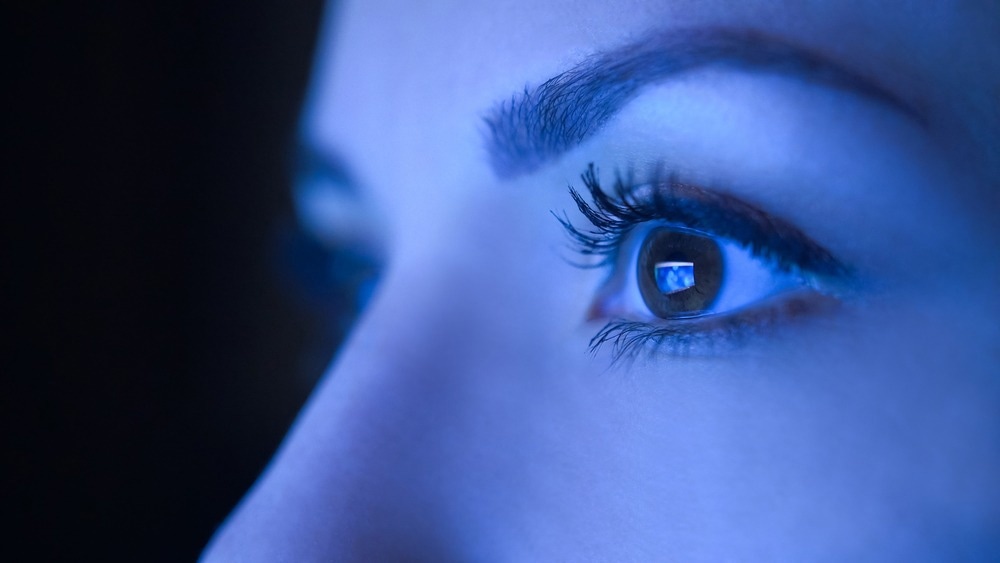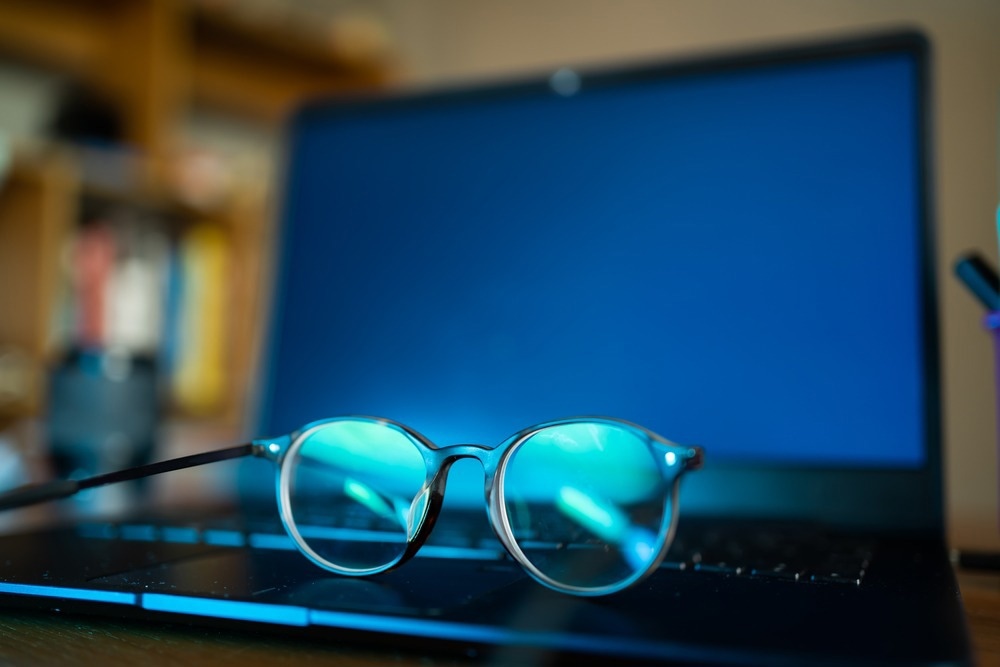Understanding digital eye strain
The science behind blue light blocking
Recent innovations in blue light-blocking solutions
Effectiveness and limitations
Integrating blue light blocking into daily life
The future of blue light technology
Conclusion
References
Further reading
Digital eye strain is an increasingly noted complaint among individuals. The ever-increasing use of technology, such as digital displays in the workplace and for entertainment, leading to greater levels of exposure to artificial blue light may play a role in this entity.
 Close-up of young woman eyes looking at monitor, working with computer, laptop. Monitor blue light is reflected in her eyes. Image Credit: Youproduction/Shutterstock.com
Close-up of young woman eyes looking at monitor, working with computer, laptop. Monitor blue light is reflected in her eyes. Image Credit: Youproduction/Shutterstock.com
This article will discuss the potential pathophysiology of digital eye strain regarding blue light exposure, alongside possible preventative strategies.
Understanding digital eye strain
Digital eye strain (DES) describes a broad set of symptoms arising from extended periods of looking at digital devices. These symptoms can be defined as either ocular or affecting the eyes, such as dryness, watering, or an itching sensation. Some patients also note blurred vision and increased light sensitivity. 1
Symptoms of DES are not limited purely to vision; however, commonly, people experiencing DES will also present with musculoskeletal symptoms, such as headaches or pain in the neck, shoulders, or back. 1,2
Whereas the non-ocular symptoms may arise due to improved posture or monitor placement, the ocular symptoms of DES have been suggested to arise due to the artificial light created by the device. 1
Currently, a large number of digital devices use LED technology in their display. LEDs, while appearing white, produce light in the blue portion of the spectral power distribution. 3
Artificial blue light from such screens has come under increasing scrutiny for its potential negative consequences on eye health. While its true impact on human health is still debated, the over-exposure of blue light on the eyes has been studied. 4
The science behind blue light blocking
Blue light has a comparatively high energy profile compared to other wavelengths of light, leading to long-term damage of the eye under extreme exposure. Such damage may appear in oxidative stress, mitochondria apoptosis (death of mitochondria), and DNA damage. 5 Damage to the eyes may occur at both the crystalline lens and retina. 4
With some researchers postulating the impact blue light exposure may have in the onset of DES, strategies to limit this contact have been developed. A key strategy focussed on involves the use of filters to remove or reduce the amount of blue light from a screen. To achieve this blue light filtering, a pigment is used in a medium that absorbs the incoming blue light.

Eyeglasses with blue light filter can protect your eyes from screens. Image Credit: Wachiwit/Shutterstock.com
Recent innovations in blue light-blocking solutions
Blue light blocking solutions have been developed for direct application to digital device screens in the form of filters or coatings. These are often made to fit specific screens and, when directly applied, limit the amount of blue light reaching the individual's eyes.
Alongside filters and coatings for digital screens, which are only applicable for the light produced by a single device, these filters may be used instead of standard glass lenses. These glasses have seen a boom in popularity, leading to research focusing on how they affect DES and other aspects of blue light exposure.
Effectiveness and limitations
Many studies have focussed on the efficacy of blue light-blocking technologies in reducing DES. While certain individual studies have seen reductions in eye fatigue in participants wearing blue light-blocking glasses, results from the majority of literature are more controversial. 6
Multiple systematic reviews, including only randomized control trials, showed no reduction of eye fatigue through the use of blue light-blocking glasses, finding a lack of evidence for their use in the general population. 7,8
When assessing these systematic reviews, however, it becomes clear that there is the potential for bias in the results. As discussed by Singh et al. in their review, a majority of studies assessing blue light-blocking glasses did not mask either the reviewers or individuals in the study (representing masking bias and performance bias). 8
A double-masked randomized controlled trial in 2021, however, showed no altering of eye strain in individuals wearing blue light filtering lenses compared to everyday clear lenses. 9
The seeming lack of efficacy of blue light-blocking technologies in preventing DES has led to some researchers suggesting alternative mechanisms. Dry eye symptoms may be produced via the reduced blink rate or incomplete blinks observed when working on digital devices. 1
Other mechanisms have also been proposed for the arising of DES symptoms. Working with a digital screen requires continual focusing and refocusing of the eyes, alongside the constant movement of the eyes. This constant work done by the eyes leads to fatigue, in turn producing eye strain. 1
Integrating blue light blocking into daily life
Even without these filters, however, several practical, easy-to-implement routines may reduce DES. Limiting daily screen time to less than 4 hours may be useful for some individuals. 1 However, in workplace environments, this may not always be possible.
Periodically looking away from screens during prolonged activities and refocusing the eyes on a distant object/area may aid in preventing DES. The 20-20-20 rule (taking a break for 20 seconds every 20 minutes to look at an object 20 feet away) has been shown to decrease DES in symptomatic individuals. 10
The set-up of digital screens may also play a role in DES. The screen of the digital device should be below the eye line of the individual, approximately 20 inches away. 1 This may help alleviate both the ocular and non-ocular symptoms of DES.
Relieve Eye Strain with these Expert Tips
The future of blue light technology
The increasing digitization of both work and leisure is unlikely to slow down, suggesting DES may become an ever-increasing concern. Some estimates place the percentage of people experiencing DES above 50%. 2
Current areas of focus in the future of DES include the increase of public awareness, both in symptomology and preventative strategies. Alongside this, there is a considerable gap in knowledge of treatment strategies for DES, as current treatments are simply symptomology and do little to address the underlying cause. 1
As mentioned previously, the lack of consensus on the efficacy of blue light-blocking filters and glasses has led to many scientists calling for high-quality longitudinal observational studies. In order to better quantify the effects artificial blue light has on ocular health. 4
Conclusion
While over-exposure to blue light is known to damage the eyes, its role in DES is still questionable, as demonstrated by the debate surrounding the seeming ineffectiveness of blue light-blocking products.
Where research may be crucial to developing preventative strategies for DES, individuals can still take their eye health into their own hands. This may include implementing the strategies described in this article alongside staying accountable for the amount of screen time used.
References
1. Kaur K, Gurnani B, Nayak S, et al. Digital Eye Strain- A Comprehensive Review. Ophthalmol Ther. 2022;11(5):1655-1680. doi:10.1007/s40123-022-00540-9
2. Sheppard AL, Wolffsohn JS. Digital eye strain: Prevalence, measurement and amelioration. BMJ Open Ophthalmol. 2018;3(1). doi:10.1136/bmjophth-2018-000146
3. Behar-Cohen F, Martinsons C, Viénot F, et al. Light-emitting diodes (LED) for domestic lighting: Any risks for the eye? Prog Retin Eye Res. 2011;30(4):239-257. doi:10.1016/j.preteyeres.2011.04.002
4. Wong NA, Bahmani H. A review of the current state of research on artificial blue light safety as it applies to digital devices. Heliyon. 2022;8(8):e10282. doi:10.1016/j.heliyon.2022.e10282
5. Ouyang X, Yang J, Hong Z, Wu Y, Xie Y, Wang G. Mechanisms of blue light-induced eye hazard and protective measures: a review. Biomed Pharmacother. 2020;130(July):110577. doi:10.1016/j.biopha.2020.110577
6. Lin JB, Gerratt BW, Bassi CJ, Apte RS. Short-wavelength light-blocking eyeglasses attenuate symptoms of eye fatigue. Investig Ophthalmol Vis Sci. 2017;58(1):442-447. doi:10.1167/iovs.16-20663
7. Lawrenson JG, Hull CC, Downie LE. The effect of blue‐light blocking spectacle lenses on visual performance, macular health and the sleep‐wake cycle: a systematic review of the literature. Ophthalmic Physiol Opt. 2017;37(6):644-654. doi:10.1111/opo.12406
8. Singh S, Keller PR, Busija L, et al. Blue-light filtering spectacle lenses for visual performance, sleep, and macular health in adults. Cochrane Database Syst Rev. 2023;2023(8). doi:10.1002/14651858.CD013244.pub2
9. Singh S, Downie LE, Anderson AJ. Do Blue-blocking Lenses Reduce Eye Strain From Extended Screen Time? A Double-Masked Randomized Controlled Trial. Am J Ophthalmol. 2021;226:243-251. doi:10.1016/j.ajo.2021.02.010
10. Talens-Estarelles C, Cerviño A, García-Lázaro S, Fogelton A, Sheppard A, Wolffsohn JS. The effects of breaks on digital eye strain, dry eye and binocular vision: Testing the 20-20-20 rule. Contact Lens Anterior Eye. 2023;46(2). doi:10.1016/j.clae.2022.101744
Further Reading
Last Updated: Feb 12, 2024